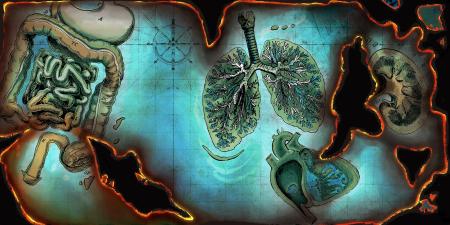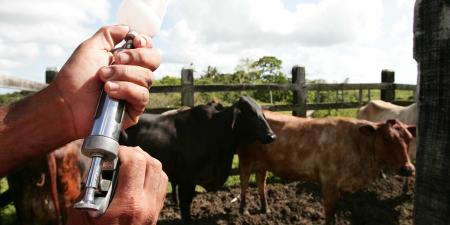Abstract
The AMA Code of Medical Ethics focuses primarily on physician responsibilities and obligations in the context of patient-physician and community-physician relationships. Nevertheless, key principles outlined in the AMA Code facilitate understanding of complex relationships among humans, nonhuman animals, and our ecosystem and offer guidance for both clinicians and professional bodies on changing ecological factors that impact individual health.
One Health in Practice
Since the onset of the COVID-19 pandemic, health professions communities have paid more attention to health ecology and One Health approaches to controlling infectious disease transmission. One Health has been defined as “the collaborative effort of multiple disciplines—working locally, nationally, and globally—to attain optimal health for people, animals and our environment.”1 Although One Health has been operationalized in medical spaces through an anthropocentric lens for the promotion of human health, it is important to note that each facet of the interdependent, triadic relationship between human, animal, and environmental health warrants moral consideration in its own right.2,3 Because of the importance of this relationship for human health,4 ecological influences on health are of heightened ethical concern and value to the American Medical Association’s (AMA’s) mission of promoting “the art and science of medicine and the betterment of public health.”5 The AMA Code of Medical Ethics outlines some of these considerations in relation to infectious disease transmission risk and prevention.
Zoonotic Transmission
Nonhuman to human animal disease transmission, known as zoonotic transmission, has heightened the threat to human well-being, as climate change and antimicrobial resistance increase risk of zoonosis.6,7 Zoonotic pathogens often mutate in ways that increase risk of transmission; notable examples of this phenomenon include the influenza, SARS, COVID-19, and Ebola viruses.8,9,10 Furthermore, current food system practices, such as factory farming, also increase the likelihood of zoonotic disease transmission.11,12 Thus, physicians should learn about and acknowledge ecological impacts on human health in order to better serve patients whose health has been compromised by zoonotic and environmentally influenced diseases.
Minimization of zoonotic disease transmission begins with clinician well-being. Opinion 9.3.1, “Physician Health and Wellness,” specifies that physicians should take “appropriate measures to protect patients, including measures to minimize the risk of transmitting infectious disease commensurate with the seriousness of the disease,”13 which should include physicians taking precautionary measures when traveling to areas experiencing a zoonotic outbreak. Should such an ecologically induced infection pose harm to patients and other clinical team personnel, steps must be taken to minimize transmission from an infected clinician or animal reservoir as much as possible. These steps can be extrapolated from Opinion 8.4, “Ethical Use of Quarantine and Isolation,”14 and Opinion 8.7, “Routine Universal Immunization of Physicians,”15 the former of which stipulates that “appropriate protective and preventive measures to minimize transmission of infectious disease from physician to patient, including accepting immunization for vaccine-preventable disease,” should be taken when such vaccines are available, safe, and effective.14 The burden of preventing transmission of and containing infectious diseases falls upon health care organizations, which “have a responsibility to proactively develop policies and procedures for responding to epidemic or pandemic disease with input from practicing physicians, institutional leadership, and appropriate specialists.”5
Medical Tourism and Xenotransplantation
Medical tourism—ie, travel abroad to seek medical care—increases the risk of global transmission of infectious and even zoonotic diseases. Not only is follow-up care difficult for medical tourists, but travelers who acquire zoonotic or vector-borne diseases abroad that are not endemic to their home countries may contribute to those diseases’ widespread transmission.16 Opinion 1.2.13, “Medical Tourism,” speaks to some of these ethical considerations, stating that medical tourists may “face heightened travel-related risks” and “may pose public health risks to their home communities.”17 As medicine becomes more globalized and medical tourism becomes more common, oversight and regulation of screening and vaccination of travelers domestically and internationally ought to be a priority.
Xenotransplantation, which is “using organs or tissues from nonhuman animal species for transplantation into human patients,” has become a novel method for addressing the shortage of transplantable organs.18 As such, the AMA Code specifies in Opinion 6.3.1, “Xenotransplantation,” that participants in xenotransplantation clinical research studies should be “informed about and consent to the unique risks and burdens” of the procedure, which could include novel infectious diseases or zoonoses and the need for lifelong surveillance.18 Additionally, considerations of patient safety and public health with regard to xenotransplantation are important to ensure dignity of care and humane treatment of animals involved in this procedure. Further research on more sustainable options for organ transplantation that prioritize these considerations through a One Health framework should be pursued.
Ecological Relationships
Opinion 8.11, “Health Promotion and Preventive Care,” states that physicians have a “professional commitment to the health of patients and the public.”19 By applying One Health and health ecology frameworks, physicians can fulfill their obligation to promote the health of the community by, for example, collaborating with epidemiologists or other public health officials to map cases of zoonotic or vector-borne diseases. Protection of public health also includes responsibilities stipulated in Opinion 8.3, “Physicians’ Responsibilities in Disaster Response and Preparedness.”20 This opinion states that physicians have a professional obligation to provide urgent medical care in disasters, which include environmental and natural disasters.
Additionally, acknowledging ecological influences on health helps physicians understand and address health care disparities, such as those mentioned in Opinion 8.5, “Disparities in Health Care.”21 Environmental inequities parallel the health inequities experienced by vulnerable populations, which were clearly evidenced during the COVID-19 pandemic when essential workers who labored in crowded conditions were more likely not only to become infected with the virus and spread its to their communities,22,23 but also to face moral injury due to inadequate workplace precautionary measures for disease prevention.24 Collaborative, interdisciplinary clinical teams that aim to “expand access to care for populations of patients,” as stated by Opinion 10.8, “Collaborative Care,” are critical for ensuring the health and well-being of individuals and communities.25
Although there is still a significant need to continue exploring ecological influences on human health, the AMA Code provides helpful guidance on minimizing disease risk and transmission, in addition to encouraging collaborative and preventive care that can be applied alongside One Health and ecological frameworks.
References
- Coghlan S, Coghlan B. One Health, bioethics, and nonhuman ethics. Am J Bioeth. 2018;18(11):3-5.
-
Johnson J, Degeling C. Does One Health require a novel ethical framework? J Med Ethics. 2019;45(4):239-243.
-
Sironi VA, Inglese S, Lavazza A. The “One Health” approach in the face of Covid-19: how radical should it be? Philos Ethics Humanit Med. 2022;17(1):3.
-
Mackenzie JS, Jeggo M. The One Health approach—why is it so important? Trop Med Infect Dis. 2019;4(2):88.
-
About. American Medical Association. Accessed March 29, 2023. https://www.ama-assn.org/about
-
Burnham JP. Climate change and antibiotic resistance: a deadly combination. Ther Adv Infect Dis. 2021;8:2049936121991374.
-
Rupasinghe R, Chomel BB, Martínez-López B. Climate change and zoonoses: a review of the current status, knowledge gaps, and future trends. Acta Trop. 2022;226:106225.
- van Herten J, Bovenkerk B, Verweij M. One Health as a moral dilemma: towards a socially responsible zoonotic disease control. Zoonoses Public Health. 2019;66(1):26-34.
- Sellars L, Bernotas K, Sebo J. One Health, COVID-19, and a right to health for human and nonhuman animals. Health Hum Rights. 2021;23(2):35-47.
-
Magouras I, Brookes VJ, Jori F, Martin A, Pfeiffer DU, Dürr S. Emerging zoonotic diseases: should we rethink the animal-human interface? Front Vet Sci. 2020;7:582743.
- Li AML. Ecological determinants of health: food and environment on human health. Environ Sci Pollut Res Int. 2017;24(10):9002-9015.
- Graham JP, Leibler JH, Price LB, et al. The animal-human interface and infectious disease in industrial food animal production: rethinking biosecurity and biocontainment. Public Health Rep. 2008;123(3):282-299.
-
American Medical Association. Opinion 9.3.1 Physician health and wellness. Code of Medical Ethics. Accessed September 8, 2023. https://code-medical-ethics.ama-assn.org/ethics-opinions/physician-health-wellness
-
American Medical Association. Opinion 8.4 Ethical use of quarantine and isolation. Code of Medical Ethics. Accessed March 29, 2023. https://code-medical-ethics.ama-assn.org/ethics-opinions/ethical-use-quarantine-isolation
-
American Medical Association. Opinion 8.7 Routine universal immunization of physicians. Code of Medical Ethics. Accessed March 29, 2023. https://code-medical-ethics.ama-assn.org/ethics-opinions/routine-universal-immunization-physicians
- Chen LH, Wilson ME. The globalization of healthcare: implications of medical tourism for the infectious disease clinician. Clin Infect Dis. 2013;57(12):1752-1759.
-
American Medical Association. Opinion 1.2.13 Medical tourism. Code of Medical Ethics. Accessed March 29, 2023. https://code-medical-ethics.ama-assn.org/ethics-opinions/medical-tourism
-
American Medical Association. Opinion 6.3.1 Xenotransplantation. Code of Medical Ethics. Accessed March 29, 2023. https://code-medical-ethics.ama-assn.org/ethics-opinions/xenotransplantation
-
American Medical Association. Opinion 8.11 Health promotion and preventive care. Code of Medical Ethics. Accessed March 29, 2023. https://code-medical-ethics.ama-assn.org/ethics-opinions/health-promotion-preventive-care
-
American Medical Association. Opinion 8.3 Physicians’ responsibilities in disaster response and preparedness. Code of Medical Ethics. Accessed March 29, 2023. https://code-medical-ethics.ama-assn.org/ethics-opinions/physicians-responsibilities-disaster-response-preparedness
-
American Medical Association. Opinion 8.5 Disparities in health care. Code of Medical Ethics. Accessed March 29, 2023. https://code-medical-ethics.ama-assn.org/ethics-opinions/disparities-health-care
-
Wei CF, Lan FY, Hsu YT, et al. Risk of SARS-CoV-2 infection among essential workers in a community-based cohort in the United States. Front Public Health. 2022;10:878208.
-
Maas S. Measuring the virus risk of essential workers and dependents. NBER Digest. March 2021. Accessed September 8, 2023. https://www.nber.org/digest/202103/measuring-virus-risk-essential-workers-and-dependents
-
Gaitens J, Condon M, Fernandes E, McDiarmid M. COVID-19 and essential workers: a narrative review of health outcomes and moral injury. Int J Environ Res Public Health. 2021;18(4):1446.
-
American Medical Association. Opinion 10.8 Collaborative care. Code of Medical Ethics. Accessed February 28, 2023. https://code-medical-ethics.ama-assn.org/ethics-opinions/collaborative-care



